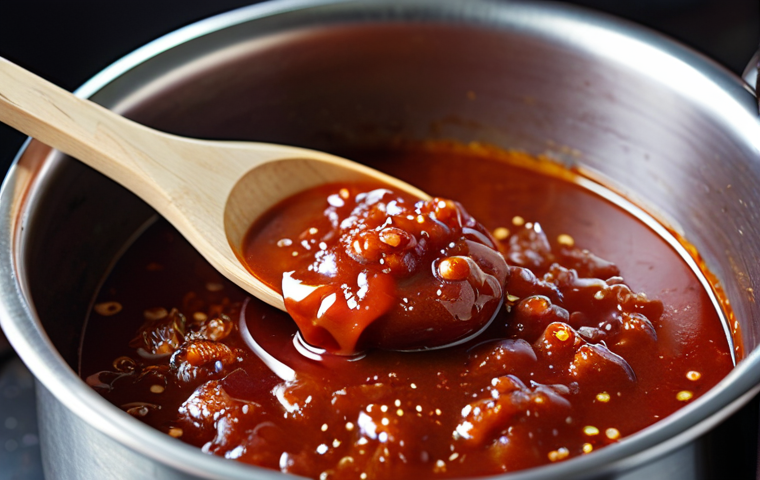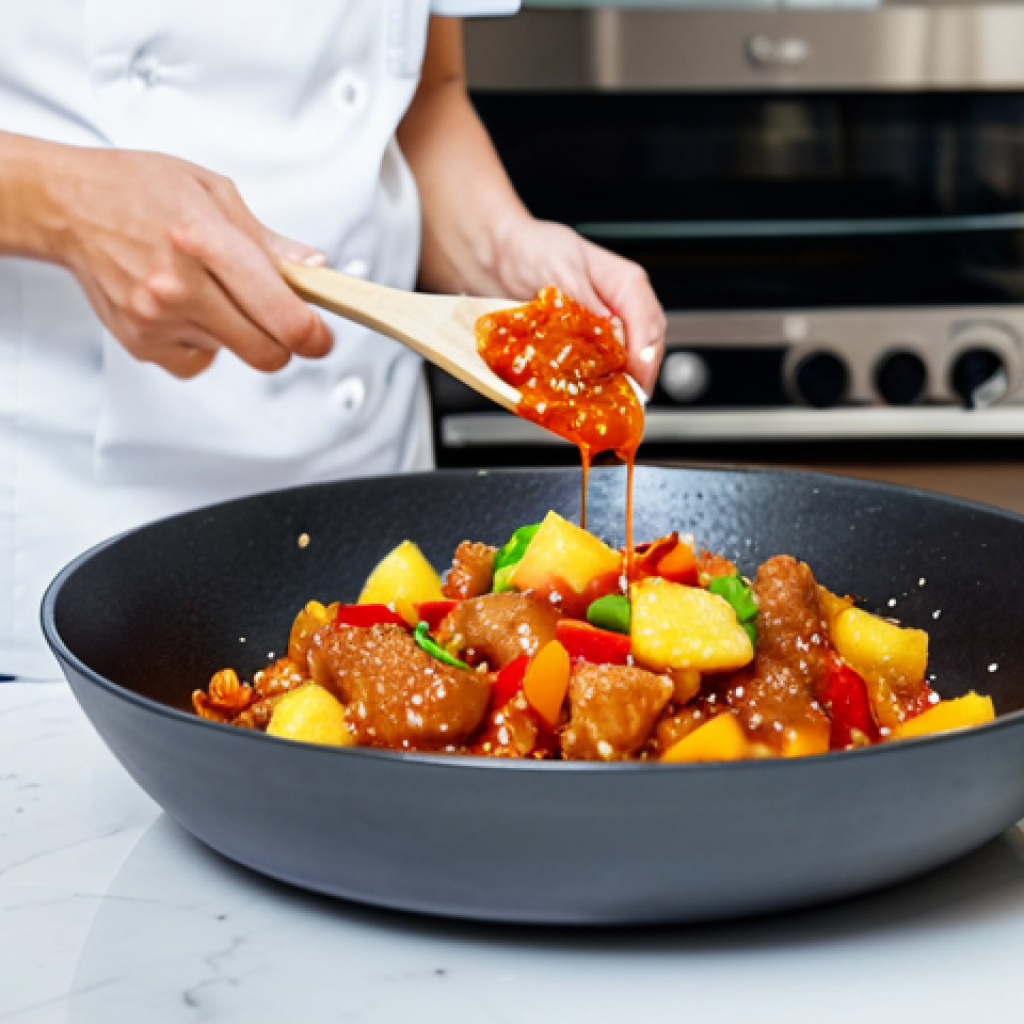Alright, here’s a blog-style introduction about Sweet and Sour Pork sauce:Let’s be honest, ordering Chinese takeout always brings that moment of delicious anticipation, especially when it comes to Sweet and Sour Pork!
That crispy, golden-fried pork swimming in that vibrant, tangy sauce…it’s simply irresistible. But have you ever wondered if you could capture that magic at home?
I’ve spent countless hours experimenting in my own kitchen, chasing that perfect balance of sweet, sour, and savory. And after many trials (and a few errors!), I think I’ve finally cracked the code.
The trends now show a greater focus on healthy alternatives for sweet and sour sauce with less sugar and fewer artificial colors and flavors. In the future, expect to see even more innovative variations, perhaps with locally sourced ingredients or fermented elements for added depth.
Let’s dive in and discover the secrets to creating the ultimate Sweet and Sour Pork sauce from scratch!
## Unlocking the Flavor: Building Your Sweet and Sour FoundationOkay, so you’re ready to ditch the pre-made jars and create a Sweet and Sour sauce that’ll make your taste buds sing?
The key here is understanding the delicate balance of flavors. It’s not just about dumping sugar and vinegar together. It’s about layering those tastes, adding depth, and creating a sauce that clings perfectly to your crispy pork.
Think of it like building a house – you need a solid foundation first!
Achieving the Perfect Sweetness: Sugar, Honey, and More

The sweetness in your sauce is crucial, and you have options! White sugar is a classic choice, providing a clean, straightforward sweetness. But don’t be afraid to experiment!
Honey adds a subtle floral note and a touch of richness. Brown sugar lends a caramel-like depth. Even maple syrup can work in a pinch!
The amount you use will depend on your personal preference, but remember to start small and taste as you go. I personally love a blend of white sugar and a touch of honey for that extra layer of flavor.
When using honey, add it towards the end of the cooking process to prevent it from burning and becoming bitter.
The Tangy Side: Vinegar Varieties and When to Add Them
Vinegar is the backbone of the “sour” element, and again, you’ve got choices! White vinegar is the standard, offering a sharp, clean tang. Rice vinegar is milder and slightly sweeter, adding a more delicate acidity.
Apple cider vinegar brings a fruity complexity. For a bolder flavor, try using a splash of balsamic vinegar, but be careful not to overdo it – a little goes a long way!
I typically opt for a combination of white vinegar for that classic tang and a splash of rice vinegar for a smoother finish. Remember to add the vinegar gradually, tasting and adjusting as you go.
Adding it too early can make the sauce overly acidic, so wait until the other flavors have had a chance to meld together.
Ketchup’s Secret Role: More Than Just a Condiment
Now, here’s where things get interesting. Ketchup is often a key ingredient in Sweet and Sour sauce recipes, and for good reason! It adds sweetness, acidity, and a depth of flavor that’s hard to replicate.
But not all ketchups are created equal. Look for a high-quality ketchup with a rich tomato flavor and minimal artificial ingredients.
Choosing the Right Ketchup: Quality Matters!
Trust me, the type of ketchup you use will make a difference in the final flavor of your sauce. Avoid the super-cheap, generic brands, as they tend to be overly sweet and lacking in depth.
Opt for a ketchup made with ripe tomatoes and a good balance of sweetness and acidity. I’ve found that using organic ketchup results in a brighter, more vibrant flavor.
When adding ketchup to your sauce, start with a small amount and taste as you go. You can always add more, but you can’t take it away!
Beyond the Bottle: Homemade Ketchup Adventures
If you’re feeling ambitious, you can even make your own ketchup from scratch! This allows you to control every ingredient and create a truly unique flavor profile.
There are tons of recipes online, and the results are well worth the effort. Homemade ketchup tends to be less sweet and more complex than store-bought versions, so you may need to adjust the other ingredients in your sauce accordingly.
This really adds that “wow” factor and shows you put in the work.
Thickening Things Up: Achieving the Perfect Consistency
Nobody wants a watery Sweet and Sour sauce! Getting the right consistency is crucial for ensuring that the sauce clings perfectly to your pork. There are several ways to thicken your sauce, each with its own pros and cons.
Cornstarch Slurry: The Classic Approach
The most common method for thickening Sweet and Sour sauce is using a cornstarch slurry. This involves mixing cornstarch with a small amount of cold water to create a smooth paste, which is then added to the simmering sauce.
The heat activates the cornstarch, causing it to thicken the sauce. Be sure to mix the cornstarch and water thoroughly before adding it to the sauce, as clumps can form if the cornstarch is not properly dissolved.
Add the slurry gradually, stirring constantly, until the sauce reaches your desired consistency. Remember, a little goes a long way!
Alternative Thickeners: Tapioca Starch and More
If you’re looking for a cornstarch alternative, tapioca starch works well. It provides a similar thickening effect but with a slightly different texture.
Arrowroot powder is another option, but it tends to produce a more translucent sauce. You can also reduce the sauce by simmering it uncovered for a longer period of time, allowing the excess liquid to evaporate.
This method takes longer but results in a richer, more concentrated flavor. I’ve experimented with all three, and I personally prefer cornstarch for its ease of use and reliable results.
The Secret Weapon: Adding Depth and Complexity
While sweetness, sourness, and thickness are essential, it’s the subtle nuances that elevate a good Sweet and Sour sauce to a great one. This is where you can really get creative and personalize your recipe.
Soy Sauce or Worcestershire: Umami Boost
A dash of soy sauce or Worcestershire sauce adds a savory umami element that balances the sweetness and acidity. Start with a small amount and taste as you go.
Too much can overpower the other flavors, so use it sparingly. I personally prefer soy sauce for its clean, salty flavor. Using low-sodium soy sauce can help control the overall saltiness of the sauce.
A few drops of fish sauce (use very sparingly!) can also work.
Ginger and Garlic: Aromatic Infusion
Freshly grated ginger and minced garlic add a warm, aromatic complexity. Sauté them in a little oil before adding them to the sauce to release their flavors.
Be careful not to burn the garlic, as it can become bitter. You can also use ginger and garlic powder in a pinch, but the flavor won’t be as vibrant. I always opt for fresh ginger and garlic whenever possible, as they add a depth of flavor that’s hard to replicate with dried spices.
Add a touch of sesame oil at the end for added depth.
Chili Flakes or Sriracha: A Touch of Heat
If you like a little kick, add a pinch of red pepper flakes or a dash of Sriracha sauce. This adds a subtle heat that complements the sweetness and sourness.
Start with a small amount and adjust to your taste. For a milder flavor, you can use a pinch of cayenne pepper. I personally love a touch of Sriracha for its tangy, garlicky heat.
A few drops of chili oil also works well.
Serving Suggestions and Variations: Beyond the Pork
Once you’ve mastered the basic Sweet and Sour sauce, the possibilities are endless! Experiment with different ingredients and serving suggestions to create your own signature dish.
Sweet and Sour Chicken or Shrimp: A Classic Twist
Of course, Sweet and Sour sauce isn’t just for pork! It’s also delicious with chicken, shrimp, or tofu. Simply coat your protein of choice in cornstarch and fry until golden brown.
Then, toss it in the Sweet and Sour sauce and serve with rice.
Stir-Fries and Vegetable Dishes: Versatile Sauce
Sweet and Sour sauce can also be used as a base for stir-fries and vegetable dishes. Add it to your favorite veggies, such as bell peppers, onions, pineapple, and carrots.
Serve over rice or noodles for a complete meal.
Dipping Sauce and More: Endless Possibilities
Sweet and Sour sauce also makes a great dipping sauce for egg rolls, spring rolls, and other appetizers. You can even use it as a glaze for grilled meats or vegetables.
Get creative and experiment with different ways to use your homemade Sweet and Sour sauce!
Troubleshooting Your Sauce: Common Problems and Solutions
Even with the best recipe, things can sometimes go wrong. Here are some common problems you might encounter when making Sweet and Sour sauce, along with solutions to fix them.
Too Sweet? Add More Vinegar
If your sauce is too sweet, add a splash of vinegar or lemon juice to balance the flavors. Taste and adjust until you reach the desired level of acidity.
Too Sour? Add More Sugar
If your sauce is too sour, add a little sugar or honey to mellow it out. Start with a small amount and taste as you go.
Too Thick? Add Water or Broth
If your sauce is too thick, add a little water or broth to thin it out. Stir until the sauce reaches your desired consistency.
Too Thin? Add More Cornstarch Slurry
If your sauce is too thin, add a little more cornstarch slurry to thicken it up. Be sure to mix the cornstarch and water thoroughly before adding it to the sauce, as clumps can form if the cornstarch is not properly dissolved.
Recipe Variations for Adventurous Cooks
Here are few recipe variations for adventurous cooks:
Spicy Sweet and Sour Sauce
Add 1-2 finely chopped chili peppers to the sauce for an extra kick.
Fruity Sweet and Sour Sauce
Incorporate diced pineapple, cherries, or mandarin oranges for a fruity twist.
Vegetarian Sweet and Sour Sauce
Use vegetable broth and tofu for a vegetarian-friendly version. Here’s a sample table consolidating key ingredients and their impact:
| Ingredient | Purpose | Flavor Contribution | Notes |
|---|---|---|---|
| White Sugar | Sweetener | Clean, straightforward sweetness | Adjust quantity to taste. |
| White Vinegar | Sourness | Sharp, tangy acidity | Can be substituted with rice vinegar for a milder taste. |
| Ketchup | Base | Adds sweetness, acidity, and tomato flavor | Choose a high-quality ketchup with a rich tomato flavor. |
| Cornstarch | Thickener | Thickens the sauce | Mix with cold water to create a slurry before adding to the sauce. |
| Soy Sauce | Umami | Adds savory depth and saltiness | Use sparingly to avoid overpowering other flavors. |
Unlocking the secrets to a perfect Sweet and Sour sauce is like discovering a new superpower in the kitchen! It’s all about balance, experimentation, and a little bit of love.
Don’t be afraid to try different variations and find what works best for your taste buds. So, grab your ingredients, put on some music, and get ready to embark on a Sweet and Sour adventure!
You’ll be amazed at what you can create.
Wrapping Up
Mastering Sweet and Sour sauce isn’t just about following a recipe; it’s about understanding flavors and feeling empowered in the kitchen. With a bit of practice, you’ll be whipping up restaurant-quality dishes in no time. So go ahead, experiment, and most importantly, have fun creating your own signature Sweet and Sour masterpiece!
Remember that the best Sweet and Sour sauce is the one that you enjoy the most. Adjust the ingredients to suit your personal preferences and don’t be afraid to get creative. The possibilities are endless!
Now that you’re equipped with the knowledge and tips to create the perfect Sweet and Sour sauce, I’m excited to see what culinary creations you come up with. Happy cooking, and may your Sweet and Sour adventures be filled with flavor and fun!
Handy Tips to Know
1. Vinegar Variety: Don’t limit yourself to just white vinegar. Experiment with apple cider or rice vinegar for different flavor profiles.
2. Ketchup Quality: Spend a little extra on good quality ketchup. The richer the tomato flavor, the better your sauce will taste.
3. Thickening Alternatives: If you’re out of cornstarch, tapioca starch works just as well. Just remember to create a slurry first to avoid clumps.
4. Umami Boosters: Soy sauce is great, but a tiny dash of fish sauce can add an extra layer of savory depth (use it sparingly!).
5. Spice Level: Go easy on the chili flakes or Sriracha. You can always add more heat, but you can’t take it away!
Key Takeaways
Sweetness: White sugar is classic, but honey or brown sugar adds depth.
Sourness: White vinegar provides a clean tang, rice vinegar a smoother finish.
Ketchup: Adds sweetness, acidity, and tomato flavor. Quality matters!
Thickening: Cornstarch slurry is the most common method.
Umami: A dash of soy sauce or Worcestershire sauce balances the flavors.
Frequently Asked Questions (FAQ) 📖
Q: Can I adjust the sweetness and sourness of the sauce to my liking?
A: Absolutely! That’s the beauty of making it at home. Start with the recipe as a base, then taste as you go.
If you prefer a tangier sauce, add a splash more vinegar. For a sweeter flavor, add a bit more sugar or even a touch of honey. Remember, it’s all about finding the perfect balance that suits your taste buds.
I personally like mine with a little extra zing!
Q: What’s the best way to get that vibrant red color in Sweet and Sour Pork sauce?
A: Traditionally, food coloring was used to achieve that intense red hue. However, I prefer a more natural approach. A combination of tomato paste and a dash of paprika can provide a lovely reddish-orange color.
For a deeper red, a tiny pinch of beetroot powder works wonders. Just be careful not to overdo it, as it can affect the flavor.
Q: Can I make Sweet and Sour Pork sauce ahead of time?
A: You sure can! In fact, I often find that the flavors meld together even better if you make it a day or two in advance. Store it in an airtight container in the refrigerator.
When you’re ready to use it, simply reheat it gently on the stovetop or in the microwave. Just be sure to give it a good stir before using. I’ve found that making a big batch on the weekend saves me a ton of time during the week!
📚 References
Wikipedia Encyclopedia






